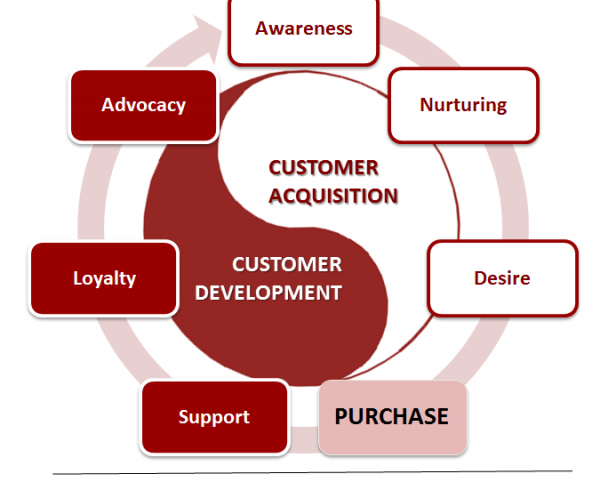There is a significant difference in the tone of a vendor-customer relationship to that of its former vendor-prospect status. The processes are different; the players are different and so too are the expectations.
This first step in the customer development sphere of the customer lifecycle is critical for both parties as it creates the foundation of what might be a profitable relationship.
Notice I used the word “might”. Too often B2B businesses take the customer’s satisfaction and loyalty for granted post-purchase. A purchase order does not guarantee loyalty. Loyalty – the second stage of the customer development sphere – is earned, not granted.
Once you’ve converted a prospect, the relationship shifts from the “get to know you” honeymoon phase to the reality of working with a client. The complexities of changing project scope, shifting needs, new employee opinions, transfer of knowledge, invoicing, payment terms, shipping delays, etc. enter the equation.
Generally, this is a more frustrating period for the customer than it is for your business; therefore, at this juncture mitigating risk is imperative to ensure the long-term value of the customer.
How well you manage this sets the stage for how rapidly – and if at all – you’ll move the customer along the lifecycle towards loyalty and eventually to advocacy. Below are three critical steps your business must take to guarantee initial customer satisfaction.
1. Digitally Map and Connect the People
In most B2B transactions, once a purchase order is issued two entirely different teams execute the deliverables. On the vendor side, sales execs and technical sales support are replaced with inside sales personnel, customer support teams and accountants.
On the customer side, the team who researched the market, the procurement team who wrote the RFP and the executives who made the purchase decision are often replaced by front line staff, marketing teams and/or warehouse personnel. It is these new players, often forced to work together with little warning or guidance, who will dictate the customer experience.
Fostering these relationships requires proper introductions complete with mapped communication paths, feedback mechanisms and tools for quick and easy contact. Sensei recommends B2B vendors create a digital map that displays names, avatars, job descriptions, responsibilities, and instant contact options for team members on both sides.
The map should be org
anized to illustrate the lines of communication that match the physical transaction between the two groups. Critical to the success of this online tool is the facilitation of in-line chat, emailing, troubleshooting, video conferencing or group discussions.
2. Document How the Customer’s Expectations Will Be Met
Once the team is introduced and connected, visually re-iterate your understanding of the customer’s need with a detailed blueprint that demonstrates exactly how your business will meet those needs. Consider it a “mission statement” that guides daily interactions with this client.
Don’t leave this to chance. Document it; have it signed; post it and reference it frequently. Within the roadmap provide a clear illustration of the delivery paths for how products and services will be provisioned, how returns are to be managed, the procedure for accessing support and the process for providing feedback.
Important: take the time to identify the possible obstacles of doing business together. What geographical or cultural issues may arise? What competitive forces are at play? Whatever is discovered, provide contingency plans and escalation paths to ensure that they take no one by surprise and that each “issue” becomes part of a regular routine and not a point of contention.
3. Set Goals and Measure
Lastly, be upfront about what you want to get out of the relationship and how that aligns with the customer’s goals. As an example: you want the customer’s loyalty and in exchange you will meet their need to have products delivered on time, 100% of the time or a 1% rebate will be issued for every day delayed.
Be sure to include long-term goals in this exercise. Where are the growth opportunities in the market for both of you to increase sales? Is there a new technology or shift in buying patterns predicted that may allow cost-cutting measures to be realized?
Next, identify how such goals will be measured. For example, you will measure your goals by tracking the next order to be placed in three months, which is expected to be 25% larger than the initial order. You will measure the customer’s goals by tracking the sell-through rate, expected to be 80% or more at full margin.
Committing to openly communicate mutual goals and how they will be measured, then posting them internally to all members will create an immediate sense of ownership among the players that will foster improved teamwork and communication.
Remember, establishing “satisfaction” within the scope of a customer development program is not based on your ability to deliver a product but the customer’s view of how that product or service met their expectations, how easy it is to do business with you and frankly, how much they enjoy working with your team.
Obstacles to satisfaction can be mitigated when teams, processes and mutual goals are quickly identified, aligned and documented.
Do you agree that such strategies would eliminate obstacles from doing business, thus creating a better longer term relationship? Share your thoughts below.
Sam Fiorella – Sensei
Feed Your Community, Not Your Ego




